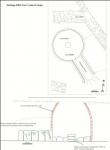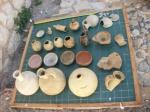Summary (English)
This rescue excavation was carried out in October 2016 on the land of a road project near the ruins of the archeological site of Vallis, at Gbollat, Béja, north-west of Tunisia.
Mostly, the excavation revealed important discoveries. – A Roman tomb covered with terracotta tiles, whose funeral artifacts included an oil lamp derived from the Deneauve VII / 5 type which date it to the first century. – A set of four pottery kilns, one of which, the largest, consists of a circular kiln with a diameter of 1m70. It’s soil was 1m65 deep. A sort of “pillar” made of clay “slabs” of of about 30 cm in diameter, sealed with a binder of lime and seems to have held the floor which also differs from the best known classical type: It ‘s made by thick clay strips 8 to 12 cm curved on one side at the edges of the kiln and restomg on the central pillar on the other side acting as retaining arches. A fire chamber opens to the south-east and is nearly 1m50 long.
The construction of the edges of the laboratory and the fire chamber was done by rectangular clay plates of dimensions varying between 25 and 50 cm sides and about 8 cm thick. They have been laid in the raw state.
The kiln itself seems to be fired only from the outside. This is explained by the presence of a layer of earth about 15 cm thick, red, that is to say having been exposed to a fire, and covering the furnace.
The excavation of this kiln has delivered a good collection in relative good condition of its last firing, usually pitchers, then, plates, cups, lids; vaultinging tubes … This material is datable within the Vth and VIth century.
Curiously, one of the jugs carries an incised decoration bearing a scene of hunting aurochs, hitherto known only in the prehistoric times especially of the Neolithic.
A bronze nummus of Constance II (337-360), was also found inside the kiln. Two smaller kilns arranged one above the other. The one from the lower level is contemporary to the first kiln in the way and level of construction, but also, the material cleared. The upper level, necessarily more recent, was about 60 cm higher. The central pillar of the laboratory is also made of clay but it’s made in a single piece in cylindrical shape of smaller dimensions.
There is a fourth kiln that we have not cleared, but we know that it’s there thanks to the discovery of a clay drum of its central pillar whose dimensions are approximately equal to the previous two and smaller than the first.
Director
- Faouzi GHOZZI
- Institut National du Patrimoine
Team
- AMMOURI Walid
- GRAMI Yassine
- ZEDDINI Nabil






![Download [PDF]](/excavation/skins/fasti/images/results/download_sml.png)

